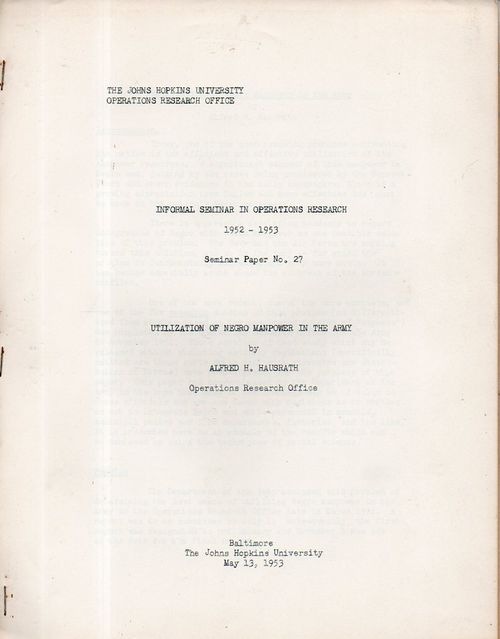HAUSRATH, Alfred H. "Utilization of Negro Manpower in the Army." Informal Seminar in Operations Research, 1952-1953, Seminar Paper No. 27. The Johns Hopkins University Operations Research Office (ORO), Baltimore, May 13, 1953. $450
The desegregation of the executive department and the U.S. Army began under Harry Truman in 1948, which for the military was formalized in the Army Reorganization Act of 1950, which called for the end of the need for segregated armed forces. Following the disaster in the Korean War in late 1950 (the Chinese Counteroffensive causing the retreat of U.N. forces south of the Yalu River in November 1950), and finding it difficult to replace soldiers with nothing but white fighting men, the Army began to integrate fighting units by March 1951. The ORO instituted a study in 1951 by a team of five analysts headed by Dr. Alfred Hausrath to study the effects of integration, part of which was published in the report (below), with the full three-volume publication of the study coming slightly later in 1954. (Two earlier interim reports were issued in July and December 1951.) Basically, after everything was said and done, the Hausrath and his team found that integrated units work much better than segregated units.
The report "provided policymakers in the Army with the objective arguments in favor of integrated units", and the polcy changes for full integration of the Army were issued jsut months after this report was rendered, in July 1951. This document was printed for the first time in a general format for OR folks in 1953. (The term "landmark" was used to describe this paper in Saul Gass' An Annotated Timeline of Operations Research, an Informal History, page 80.)
Abstract: In connection with a basic policy decision by the Army in 1951 on the utilization of Negro manpower, a partly quantitative operations research study was made. Factors affecting the decision to integrate Negroes into previously all-white. Army units included statistics of scores on the Army's General Classification Test, Negro and white performance in combat, and interactions between Negro and white soldiers as determined from attitudes, opinions, critical incidents, and actual behavior. It is concluded that integrated (white and Negro) units can make more effective use of available manpower than segregated units, that resistance to integration is reduced as experience in integrated units is gained, and that levels of 20 per cent Negroes and more are acceptable. The time required to extend integration to the whole Army is discussed, and difficulties presented in such a manner that a sound program can be devised Operations Research, Informs/Online





Comments